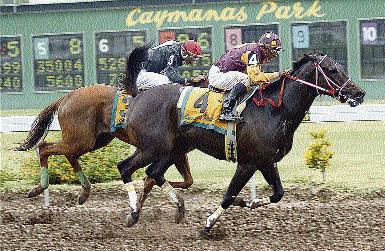
More than two years ago, I gave general advice (Public Opinion’s Birthday; Your Gift – Speed!) about how to assess speed. It’s time for more advanced study.
“Oh my ears and whiskers, how late it’s getting!”
That notorious exclamation by a distressed (and unusual) White Rabbit appears in Lewis Carroll’s seminal work Alice In Wonderland and is the text from which this week’s sermon is preached. Now, here’s a rabbit who could teach us a thing or two about speed, which is what I’m getting around to eventually. Those of you who guessed this week’s message is all about speed go to the head of the class. You’ve been selected to read for the highest academic qualification in the Faculty of Handicapping. After completing these studies, you’ll be awarded an STPD (buy a vowel or two from Vanna White) Degree, your Doctorate in Stopwatch Speed. Henceforth, you’ll be known as Joe Punter STPD or, if you prefer, the ladies can just call you Joe.
Can I get an Amen?
Now, why is my Church preaching about speed? No, Joe, not THAT Speed. I’m talking about production not ingestion of Speed. You see, brothers and sisters, boys and girls, my Church is a sympathetic Church. It’s a Church that wants to see its members fulfilled in this life AND the next. We are tired of seeing members at Church on Sunday mornings depressed and lifeless after looooong Saturday afternoons spent in the ruck. Everyone has their favourites and two out of every three favourites end up in the ruck. So, my Church is dedicated to producing bright-eyed, bushy-tailed members on a Sunday morning; Members who can dig deep as the plate approaches them; Members who are no longer in the ruck.
So, welcome, brothers and sisters, boys and girls, to The Church Out Of The Ruck!
Racing is all about speed. The quickest one to cover the entire distance wins. Simple, isn’t it? Of course not. Suppose Horse A runs 1,200 metres on January 1 in 1:15.0 and Horse B covers the same trip ten days later in 1:15.3. When they meet in February, over 1,200 metres, should Horse A beat Horse B by three lengths, at the same handicaps?
It ain’t necessarily so. Here are some of the “imponderables” you’ll need to analyze. What were the relative conditions of the two racetrack surfaces on January 1 and 11? Sloppy, muddy, slow, good or fast? If slow or fast, was January 1 slower or faster than January 11 and by how much? What were the wind factors? Can I work out an absolute time for the two races so that I can compare them as apples and apples instead of apples and mangoes?
Yes you can, Sherlock, but it’s going to take some work (and some working out). Here’s the theory, you’ll have to do your own practical. Each race day includes races from varied grades over a variety of distances. If we knew what times these nags ran, on average, for each of those distances, we’d be able to calculate, for each race on a ten race card (for example), how much faster or slower than the average for the category and distance it was. We’d end up with ten “variants”.
Then, just like in Olympic Diving, all you have to do is throw out the highest and lowest “variant” (to eliminate aberrations like Mahogany or Pure Heart) and calculate the average of the remaining eight. Then, voila, you’ll have the day’s Track Variant and will be able to calculate an absolute time for each race run that day.
Here’s how it’s done in practice:
- You’ll need at least one year’s results and a blank pad (or computer spread sheet if you must);
- Divide the pad into Grades (down the left margin) and distances, from shortest to 1,600 metres (across the top).
- Fill each category with the individual times of each race run during the year. Do not include times recorded on a muddy or sloppy racetrack;
- You shouldn’t accept less than 12 qualified times for each distance (sigh; sometimes life forces us to adjust pending sufficient data at infrequent distances);
- When you have 12 qualified times for a category/distance, throw out the slowest and fastest and calculate the average of the remaining ten.
That’s the average (a.k.a. Standard or Par) time for the class and distance. Soon enough, you’ll be able to prepare a Table of Standard Times for every distance (up to 1,600 metres; beyond that final time is irrelevant) in every class. After that, the track variant for a particular day is simply the result of a similar calculation using the day’s official times. For each race on the round course (do a separate calculation for the straight course — a strange creature), calculate how many fifths of a second faster or slower the final time is than the particular Standard Time then divide the result by the number of furlongs (or 200s of metres) in order to get a number (fast or slow) in fifths of a second per furlong/200m for each race. Throw out the highest and lowest number. Average the rest. That average is your day’s Track Variant.
Check out this issue’s Clocked-In Department to see how this method worked on last weekend’s Guineas trials. Next time, more advanced speed studies as we compare performances at different distances and produce Speed Figures.
DEPARTMENTS:
Clocked-In
Abbreviations: CT = “Corrected Time”; TV = “Track Variant” (a calculation of track conditions’ effect on official times to arrive at “real/corrected” times); TVs are expressed in fifths of a second; “minus” (-) means a fast track; “plus” (+) a slow track (e.g -2 is fast by 2/5th second). Variants beside horse’s names represent the difference between its official time and the grade standard.
MAY 7, 2022 [TV+0.5 per 200m (Round) +3 (straight)]
Atomica (-8) produced a breathtaking performance (Race 10; 3yo fillies Graded Stakes; 1500m; TV+4) to demolish a high quality field and win by eleven lengths in 1:32.3. Her CT (1:31.4) is already 4/5th second faster than Open Allowance standard. She’s an exciting prospect. The splits (24.3; 47.2; 1:11.1) disclose she ran the final 300 in a tick slower than 21.2 (corrected for the track variant)
Sunday May 8, 2022 [TV+0.1 per 200m (Round) +5 (straight)]
Blue Vinyl (-2) quickened up nicely (Race 9; 3yo colts/geldings; Graded Stakes; 1,500m; TV+1) to win going away in 1:32.4. His CT (1:32.3) is better than 2,000 Guineas Standard at the trip (1:33.1) so, if he gets the fast early pace he needs in that race *(today’s splits 23.2; 46.2: 1:11.3) he should take all the beating. The last 300 was run in a CT of 21.1!
Overseas Betting Opportunities (OBOs)
This weekend features the French 1,000 and 2,000 Guineas (Sunday) while the PGA Championship tees off at Southern Hills on May 19.
My early pick for the English 1,000 Guineas Homeless Songs avoided the race because trainer Dermot Weld felt Longchamp would suit his filly better than Newmarket. So she goes for the Poule d’Essai des Pouliches instead. She’s an even more confident selection there.
Breeders Cup Juvenile Turf winner Modern Games is favourite for the Poule d’Essai desPoulains (French 2,000) on his seasonal reappearance but may need the run. Also he lost his only race on ground softer than good so is vulneravble. The two to concentrate on here were first and third in the Group 3 Greenham (Newbury; 7f). They are, respectively, Perfect Power (6¼ lengths 7th of 15 in the English 2,000) and Angel Bleu (winner of the Group 1 Grand Criterium at Longchamp in October). Although the former won the Greenham, the latter may have needed the run (keen to post; sweating; took keen hold, led, ridden and hard pressed over 1f out, headed inside final furlong, no extra and lost second post; beaten 1½ lengths) and could’ve been victimized by the quickish ground. He showed an uncharacteristic change of pace to lead that day and I expect him to turn the form around on what should be easier going.
Southern Hills is likely to test approach shots into small greens so I fancy an in-form Rory MciLroy to add another PGA Championship to his resume at the expense of my early pick Collin Morikawa.
Here’s another notebook horse for the flat:
Dhahabi [4yo b.c. Frankel-Fleche D’or (Dubai Destination)] made a promising return to action (May 2; Newmarket; Class 2 Heritage Handicap; 9f; good) on only his fourth career start after missing 2021. In 2020 he made a winning debut (Newmarket) then 2nd (listed race; Newbury) and 3rd to stablemate One Ruler in the Autumn Stakes (Newmarket). He showed lots of retained ability before the lack of an outing told late on. As a half-brother to Derby/Arc winner Golden Horn, his future is in pattern races over longer trips. He’s one to keep onside for Royal Ascot in a race like the Hardwicke.
Good Luck!



